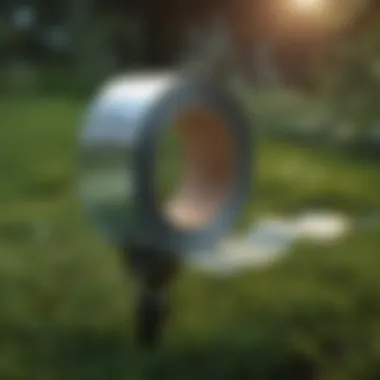Proven Strategies for Keeping Birds Away from Freshly Planted Lawns


Gardening Tips
When it comes to deterring birds from newly seeded lawns, there are several effective strategies that homeowners can implement to protect their grass and promote successful growth. Bird interference can be detrimental to the germination of seeds and the overall establishment of a healthy lawn. In this section, we will delve into practical tips and techniques that can be utilized to discourage birds from wreaking havoc on freshly seeded areas. By understanding the habits and behaviors of birds, homeowners can take proactive measures to safeguard their lawn from avian disruptions.
Understanding Bird Behavior
Before deploying any deterrent measures, it is crucial to comprehend the behavior of birds that pose a threat to newly seeded lawns. Different bird species may exhibit varying feeding and nesting habits, which can impact the vulnerability of a lawn to bird damage. By identifying the specific types of birds in the area and their typical foraging patterns, homeowners can tailor their prevention strategies effectively.
Utilizing Physical Barriers
One of the most straightforward ways to deter birds from accessing freshly seeded lawns is by installing physical barriers. These barriers can include bird netting, floating row covers, or even strategic placement of visual deterrents such as scarecrows or shiny objects. By creating obstacles that impede birds from landing and pecking at the seeds, homeowners can drastically reduce the likelihood of bird-related damage.
Implementing Sound and Motion Deterrents
In addition to physical barriers, sound and motion deterrents can be effective tools in deterring birds from newly seeded lawns. Devices that emit noises or move intermittently, such as wind chimes or spinning rods, can disrupt birds' comfort and alertness, deterring them from settling on the lawn. These auditory and visual stimuli create an inhospitable environment for birds, encouraging them to seek alternative foraging areas.
Encouraging Natural Predators
Another natural approach to bird deterrence involves attracting and supporting natural predators of problematic avian species. Species like hawks, owls, or snakes can help keep bird populations in check by preying on them. Creating habitats or installing birdhouses to attract these predators to the vicinity can serve as a sustainable and eco-friendly method of bird control.
Maintaining Cleanliness and Consistency
Consistent lawn maintenance practices, such as regularly mowing the grass and removing fallen seeds, can contribute to reducing the attractiveness of a newly seeded lawn to birds. By eliminating food sources and keeping the area clean, homeowners can discourage birds from frequenting the lawn. Furthermore, ensuring proper hydration and fertilization of the grass can promote rapid growth and resilience, making the lawn less susceptible to bird-related damage.
Understanding the Challenge
In the realm of maintaining lush lawns and promoting successful grass growth, the nuisance posed by avian creatures cannot be understated. Understanding the challenge presented by birds when it comes to newly seeded lawns is paramount for homeowners and gardening enthusiasts alike. The delicate balance of germinating seeds and the potential soil disruption caused by these feathered intruders requires careful consideration and proactive measures to safeguard the hard work put into cultivating a pristine lawn. By delving into the intricacies of bird deterrence strategies, individuals can ensure that their efforts in lawn care are not in vain.
Why Birds Pose a Threat to Newly Seeded Lawns
Impact of Birds on Germinating Seeds
One of the primary concerns in the context of birds targeting newly seeded lawns is their detrimental impact on germinating seeds. The voracious appetite of birds can lead to significant seed loss, hindering the natural growth process of the grass. This aspect underscores the need for effective deterrent measures to counteract this threat. Implementing strategies to protect germinating seeds is crucial for fostering a healthy lawn and preventing setbacks in the seeding process. Understanding the specifics of how birds interact with germinating seeds is key to formulating a tailored approach to ward off these unwelcome visitors.
Risk of Soil Disturbance by Foraging Birds


Another critical issue arising from bird activity on newly seeded lawns is the risk of soil disturbance caused by foraging birds. As birds peck and probe the soil in search of food, they can upturn delicate seedlings and disrupt the uniformity of the lawn surface. This behavior not only jeopardizes the aesthetic appeal of the lawn but also compromises the structural integrity of the grass bed. By acknowledging the potential for soil disturbance by foraging birds, individuals can preemptively address this concern through targeted bird deterrence tactics. Proactive measures aimed at mitigating soil disruption play a significant role in preserving the integrity of newly seeded lawns and promoting optimal growth conditions.
Common Bird Species that Target Lawns
Sparrows
Among the roster of common bird species that pose a threat to lawns, sparrows stand out due to their pervasive presence and foraging habits. Sparrows are known for their opportunistic feeding behavior, showing a particular affinity for lawns with freshly scattered seeds. This predisposition makes them a formidable challenge for individuals seeking to protect their newly seeded lawns from avian interference. Understanding the nuances of sparrows' behavior patterns is essential in formulating targeted strategies that deter these birds effectively. By implementing measures specifically tailored to deter sparrows, homeowners can fortify their defense against these feathered adversaries.
Starlings
Starlings, with their gregarious nature and insatiable appetite, represent another prevalent threat to newly seeded lawns. These birds flock in large numbers, descending upon freshly seeded areas with remarkable speed. The robust feeding habits of starlings can result in widespread seed consumption, impeding the emergence of new growth and compromising the overall lawn health. Combatting the menace posed by starlings requires a multifaceted approach that addresses their distinct behavioral traits and foraging preferences. Developing a nuanced understanding of starlings' activities is instrumental in devising strategies that deter these birds effectively, safeguarding the integrity of freshly seeded lawns.
Robins
Robins, characterized by their distinctive chestnut plumage and cheerful presence, are yet another common bird species known to target lawns in search of sustenance. These ground-feeding birds exhibit a keen interest in lawns that offer an abundant supply of insects and grubs, making freshly seeded areas particularly appealing to them. The foraging behavior of robins can lead to seed consumption and soil disruption, posing a significant challenge to lawn maintenance efforts. By recognizing the foraging patterns and preferences of robins, individuals can tailor their bird deterrent strategies to dissuade these birds from interfering with the healthy growth of newly seeded lawns. Equipping oneself with knowledge about robins' foraging behavior is instrumental in implementing effective measures that mitigate their impact and safeguard the vitality of newly seeded grass.
Natural Deterrents
In the realm of maintaining newly seeded lawns, Natural Deterrents play a vital role in safeguarding the delicate balance of a burgeoning lawn ecosystem. These deterrents, derived from organic elements, serve as a barrier against avian interference, ensuring the undisturbed growth of the freshly sown grass. Homeowners and gardening enthusiasts must grasp the essence of Natural Deterrents to shield their lawns effectively.
Planting Bird-Repellent Vegetation
As a fundamental aspect of Natural Deterrents, planting bird-repellent vegetation acts as a strategic means to discourage avian activity and protect newly seeded lawns. Within this category, specific flora such as Lavender, Marigolds, and Thorny Shrubs prove to be formidable allies in the battle against bird intrusion. Learn more about their distinct qualities and contributions below.
Lavender
Lavender, known for its fragrant blossoms and elegant appearance, holds a distinguished place in the arsenal of bird-repellent vegetation. The key characteristic of Lavender lies in its aromatic properties, emitting a fragrance that birds find displeasing, thus deterring them from foraging on the lawn. This botanical gem stands out as a popular choice for its natural beauty and efficacy in warding off birds, making it a valuable asset for lawn protection. Despite its benefits, some considerations like maintenance requirements may pose challenges for homeowners seeking to incorporate Lavender into their bird deterrence strategy.
Marigolds
In the realm of bird-repelling options, Marigolds emerge as a beacon of protection for newly seeded lawns. Their vibrant hues and robust nature not only enhance the visual appeal of the lawn but also serve as a potent deterrent against avian threats. The distinctive feature of Marigolds lies in their strong scent and bitter taste, acting as natural repellents that birds find unappealing. This makes Marigolds a beneficial choice for those looking to fortify their lawns against bird damage. However, it's essential to note that while Marigolds offer significant advantages, their potential for attracting insects might require careful monitoring and management by homeowners.
Thorny Shrubs
Among the array of bird-repellent vegetation, Thorny Shrubs stand out for their formidable defense mechanisms against avian intruders. Their key characteristic lies in the sharp thorns that act as physical barriers, discouraging birds from landing and foraging on the lawn. This unique feature of Thorny Shrubs makes them an attractive choice for homeowners seeking a low-maintenance yet effective solution to protect their newly seeded lawns. Despite their advantages in bird deterrence, Thorny Shrubs might pose challenges in terms of landscaping aesthetics, requiring thoughtful placement and integration into the overall lawn design to maximize their benefits and minimize potential drawbacks.
Utilizing Natural Predators


In the intricate tapestry of lawn protection, harnessing the power of natural predators represents a strategic approach to mitigating bird threats and fostering a healthy lawn environment. By attracting Birds of Prey and installing Owl Decoys, homeowners can leverage nature's own defenses to deter avian intruders effectively. Delve into the nuanced intricacies of these predator-driven strategies for optimal protection.
Attracting Birds of Prey
Attracting Birds of Prey signifies a symbiotic relationship between natural predators and garden protection, offering a sustainable solution to bird deterrence. Their key characteristic lies in their predatory instincts, preying on smaller birds that pose a threat to newly seeded lawns. This beneficial symbiosis not only safeguards the lawn but also contributes to the natural balance of the ecosystem. While attracting Birds of Prey brings about numerous advantages in terms of bird control, considerations such as potential displacement of smaller bird species and specialized habitat requirements must be carefully evaluated by homeowners.
Installing Owl Decoys
The installation of Owl Decoys serves as a visual deterrent, simulating the presence of a predator to ward off birds from newly seeded lawns. Their key characteristic lies in the realistic design that effectively intimidates birds, dissuading them from encroaching on the lawn. This strategic decoy tactic proves to be a popular choice for homeowners seeking a low-maintenance and non-invasive method of bird deterrence. While Owl Decoys offer distinct advantages in terms of effectiveness and ease of use, considerations regarding placement for optimal impact and periodic relocation to maintain efficacy should be taken into account to ensure continuous protection of the lawn from avian threats.
Physical Barriers
In the realm of bird deterrent strategies for newly seeded lawns, the significance of physical barriers cannot be overstated. These barriers serve as a shield against avian intrusion, safeguarding the tender seeds and soil beneath. By erecting barriers like netting or mesh, homeowners ensure a protective layer that prevents birds from accessing the seeded areas. The use of physical barriers acts as a practical solution, deterring birds effectively without causing harm to the feathered visitors or the emerging grass.
Installing Netting or Mesh
Installing netting or mesh stands out as a pivotal method in the arsenal of techniques to safeguard newly seeded lawns. Proper installation techniques play a crucial role in optimizing the efficacy of this approach. Ensuring the net or mesh is securely fastened without gaps or loose ends is imperative to prevent birds from slipping through. The choice of material used for the netting or mesh is equally essential. Opting for durable and weather-resistant materials guarantees long-lasting protection for the freshly sown seeds and promotes uninterrupted growth.
Proper Installation Techniques
When discussing proper installation techniques for netting or mesh, attention to detail is paramount. Securing the netting tightly to the ground, extending it above the seeded area, and inspecting for any potential openings are key aspects to consider. By meticulously following these installation steps, homeowners create an effective bird deterrent barrier that functions optimally.
Choosing the Right Material
Selecting the appropriate material for netting or mesh involves evaluating factors like durability, mesh size, and weather resistance. Materials such as nylon or polyethylene, known for their durability and strength, are popular choices for creating an effective bird barrier. The right material not only provides sturdy protection but also ensures that the barrier blends seamlessly into the lawn environment, minimizing visual impact.
Creating Noise and Disturbances
In the realm of deterring birds from newly seeded lawns, the strategic use of noise and disturbances serves as another effective tactic. Implementing elements like wind chimes introduces auditory cues that deter birds from settling in the vicinity. Motion-activated devices capitalize on sudden movements and sounds to startle birds, enhancing the effectiveness of the deterrent strategy.
Wind Chimes
Utilizing wind chimes as a noise-based deterrent proves to be a subtle yet impactful method. The gentle tinkling of the chimes disrupts the tranquility of the area, creating a dynamic auditory landscape that discourages bird activity without causing harm. Wind chimes blend harmoniously with outdoor settings, offering an aesthetic appeal while serving a functional purpose in protecting newly seeded lawns.
Motion-Activated Devices


Motion-activated devices add a layer of modern innovation to bird deterrence, triggering responses based on avian movement. These devices employ sensors to detect bird presence, activating sound or light signals that startle and deter the feathered intruders effectively. By harnessing technology in this manner, homeowners can safeguard their freshly seeded lawns with minimal intervention and maximum effectiveness.
Homemade Remedies
Homemade remedies play a crucial role in deterring birds from newly seeded lawns. They offer a natural and cost-effective approach to protecting the seeds and ensuring successful growth of the grass. Homeowners and gardening enthusiasts often turn to homemade solutions due to their eco-friendliness and minimal impact on the environment. When considering homemade remedies, it is essential to take into account factors such as effectiveness, safety for the grass, and ease of application. By incorporating DIY bird repellent sprays and vinegar soak for seeds, individuals can actively prevent avian interference and nurture their lawns to thrive.
DIY Bird Repellent Sprays
Cayenne Pepper Solution
The Cayenne Pepper Solution stands out as a potent homemade bird repellent due to its ability to deter birds effectively without causing harm to the grass. Its key characteristic lies in the active component of capsaicin, the compound responsible for the pepper's spiciness, which irritates birds without being toxic. This natural deterrent is a popular choice for its non-toxic nature, making it a safe option for newly seeded lawns. One unique feature of Cayenne Pepper Solution is its versatility in repelling a variety of bird species, providing comprehensive protection for the grass. While its advantages include affordability and eco-friendliness, some may find its pungent aroma a drawback.
Citrus-Based Sprays
Citrus-Based Sprays offer another effective DIY bird repellent solution for deterring birds from newly seeded lawns. The key characteristic of these sprays lies in the strong citrus scent, which birds find unpleasant and tend to avoid. This natural method is a beneficial choice as it leverages the natural aversion of birds to citrus aromas, making it a popular option for protecting the grass. A unique feature of Citrus-Based Sprays is their ease of preparation and application, offering a convenient solution for homeowners seeking efficient bird deterrents. While their advantages include safety and affordability, it is important to note that excessive application may impact the grass negatively.
Vinegar Soak for Seeds
Vinegar soak for seeds is a valuable homemade remedy that aids in safeguarding newly seeded lawns from avian interference. Focusing on the Recipe and Application aspect, vinegar soak serves as a natural barrier that discourages birds from foraging on the seeds. Its key characteristic lies in the acidity of vinegar, which acts as a deterrent while promoting seed safety and growth. This beneficial choice enhances the protection of seeds without harmful chemicals, aligning with environmentally conscious practices. A unique feature of vinegar soak is its simplicity in preparation and application, requiring minimal effort from homeowners to implement effectively. While its advantages include affordability and natural composition, individuals should be cautious about using excessive vinegar, which may have adverse effects on seed germination.
Professional Solutions
Professional solutions play a crucial role in safeguarding newly seeded lawns from avian threats. Harnessing the expertise of pest control professionals can elevate bird deterrence strategies to a more effective level. These professionals bring in-depth knowledge and experience that can address bird-related issues comprehensively. By opting for professional solutions, homeowners can access specialized techniques tailored to their specific lawn and bird species challenges. Moreover, these experts can provide a strategic and long-term approach to bird control, ensuring sustained protection for the newly seeded lawn.
Consulting Pest Control Experts
Integrated Pest Management
Integrated Pest Management (IPM) represents a pivotal component in holistic bird deterrence tactics. Emphasizing preventive measures over reactive solutions, IPM integrates environmentally sensitive practices to manage bird populations effectively. Its focus on sustainable and least-toxic interventions aligns perfectly with the goal of protecting newly seeded lawns without compromising environmental integrity. By combining cultural, biological, and physical control methods, IPM minimizes bird-related harm while promoting ecosystem balance.
Safe Bird Control Methods
Safe Bird Control Methods adopt a humane and non-lethal approach to managing bird activity around newly seeded lawns. These methods prioritize the well-being of both birds and plant life, ensuring a harmonious coexistence. Utilizing deterrents like visual scares, physical barriers, and safe repellents, these methods discourage birds without causing harm. By choosing safe bird control methods, homeowners contribute to preserving biodiversity and fostering a bird-friendly environment.
Installing Electronic Repellent Systems
Ultrasonic Devices
Ultrasonic devices operate by emitting high-frequency sound waves that are aversive to birds, deterring them from the area. Their silent operation makes them inconspicuous yet effective in repelling various bird species without disturbing household members or pets. Ultrasonic devices offer a humane and eco-friendly solution to bird control, creating a hostile environment for birds without causing harm. Their adaptability and ease of use make them a popular choice for integrating into newly seeded lawn protection strategies.
Bird-X Systems
Bird-X Systems utilize innovative technology to repel birds through sonic sounds, creating an uncomfortable environment for avian visitors. These systems emit a combination of distress calls and predator noises, simulating a natural predator presence to deter birds effectively. By leveraging sound frequencies that mimic bird alarm calls, Bird-X Systems trigger avoidance behaviors in targeted bird species, mitigating damage to newly seeded lawns. Their customizable features and proven effectiveness make them a valuable asset in maintaining a bird-free lawn environment.







